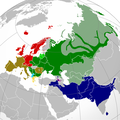Bestand:Indo-European branches map.png

Grootte van deze voorvertoning: 599 × 600 pixels. Andere resoluties: 240 × 240 pixels | 479 × 480 pixels | 767 × 768 pixels | 1.023 × 1.024 pixels | 2.045 × 2.048 pixels | 2.934 × 2.938 pixels.
Oorspronkelijk bestand (2.934 × 2.938 pixels, bestandsgrootte: 2,16 MB, MIME-type: image/png)
Bestandsgeschiedenis
Klik op een datum/tijd om het bestand te zien zoals het destijds was.
| Datum/tijd | Miniatuur | Afmetingen | Gebruiker | Opmerking | |
|---|---|---|---|---|---|
| huidige versie | 26 sep 2022 05:43 |  | 2.934 × 2.938 (2,16 MB) | Alexikoua | minor fixes |
| 30 mrt 2022 17:58 |  | 2.934 × 2.938 (1,74 MB) | Whoop whoop pull up | Whoops, wrong file! | |
| 30 mrt 2022 17:37 |  | 2.048 × 2.048 (980 kB) | Whoop whoop pull up | Misc fixes (Russian minority in Svalbard & Israel, Slovenian in SE Carinthia, Greek in N Epirus, Aromanians/Megleno-Romanians, Swedish essentially extinct in Estonia, etc. | |
| 22 dec 2021 11:37 |  | 2.934 × 2.938 (1,74 MB) | Ahmet Q. | Reverted to version as of 19:55, 23 August 2021 (UTC)seek consensus for your changes | |
| 25 nov 2021 22:40 |  | 2.934 × 2.938 (2,16 MB) | Alexikoua | rv elimination of Greek minority in Albania | |
| 23 aug 2021 21:55 |  | 2.934 × 2.938 (1,74 MB) | Ahmet Q. | Rv false edit summary. Overrepresentation of Greeks in Turkey, Albania and Ukraine. Unexplained removal of Romanian in Serbia. Overall deterioration of the original file. Seek consensus for your changes. | |
| 7 aug 2021 18:16 |  | 2.934 × 2.938 (2,16 MB) | Demetrios1993 | Addition of Arbereshe linguistic minority in Sicily. Addition of Serbian, Bosnian, and Gorani linguistic minorities in Kosovo. Addition of Greek linguistic minorities in Italy, Albania, Turkey, and Ukraine. Including some other minor corrections. | |
| 19 nov 2020 19:00 |  | 2.934 × 2.938 (1,74 MB) | Golden | update Armenian | |
| 31 mrt 2018 20:42 |  | 1.479 × 1.479 (574 kB) | Maphobbyist | Removed area that exactly corresponds to the non-Indo European Lezgi linguistic area. | |
| 6 sep 2016 23:37 |  | 1.479 × 1.479 (620 kB) | Rob984 | Georgia and Azerbaijan aren't majority multilingual. Older generations speak Russian from the Soviet era but now English is taught mainly in place of Russian. More people speak English in Finland, yet that isn't coloured. Also corrections to Celtic are... |
Bestandsgebruik
Dit bestand wordt op de volgende 4 pagina's gebruikt:
Globaal bestandsgebruik
De volgende andere wiki's gebruiken dit bestand:
- Gebruikt op ast.wikipedia.org
- Gebruikt op ban.wikipedia.org
- Gebruikt op be-tarask.wikipedia.org
- Gebruikt op be.wikipedia.org
- Gebruikt op bg.wikipedia.org
- Gebruikt op cs.wikipedia.org
- Gebruikt op da.wikipedia.org
- Gebruikt op de.wikipedia.org
- Gebruikt op en.wikipedia.org
- Gebruikt op en.wikiversity.org
- Gebruikt op es.wikipedia.org
- Gebruikt op et.wikipedia.org
- Gebruikt op eu.wikipedia.org
- Gebruikt op fa.wikipedia.org
- Gebruikt op fi.wikipedia.org
- Gebruikt op frr.wikipedia.org
- Gebruikt op fr.wikipedia.org
- Gebruikt op gl.wikipedia.org
- Gebruikt op gu.wikipedia.org
- Gebruikt op gv.wikipedia.org
- Gebruikt op hak.wikipedia.org
- Gebruikt op he.wikipedia.org
- Gebruikt op hy.wikipedia.org
- Gebruikt op hyw.wikipedia.org
- Gebruikt op ilo.wikipedia.org
- Gebruikt op incubator.wikimedia.org
- Gebruikt op io.wikipedia.org
Globaal gebruik van dit bestand bekijken.


